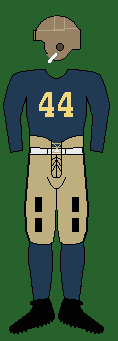
The 1933 Michigan Wolverines football team represented the University of Michigan in the 1933 Big Ten Conference football season. Under fifth-year head coach Harry Kipke, Michigan compiled an undefeated 7–0–1 record, outscored opponents 131 to 18, extended the team's unbeaten streak to 22 games, and won both the Big Ten Conference and national football championships. The defense shut out five of its eight opponents and gave up an average of only 2.2 points per game. In December 1933, Michigan was awarded the Knute K. Rockne Trophy as the No. 1 team in the country under the Dickinson System. By winning a share of its fourth consecutive Big Ten football championships, the 1933 Wolverines also tied a record set by Fielding H. Yost's "Point-a-Minute" teams from 1901 to 1904.
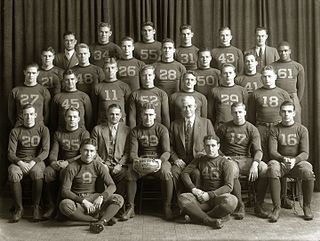
The 1932 Michigan Wolverines football team represented the University of Michigan in the 1932 Big Ten Conference football season. Under fourth-year head coach Harry Kipke, Michigan compiled a perfect 8–0 record, outscored opponents 123–12, and won both the Big Ten Conference and national championships. The defense shut out six of its eight opponents and gave up an average of only 1.6 points per game. The Knute K. Rockne Trophy was presented at the end of the season to the team deemed to be the national champion using the Dickinson System, a rating system developed by Frank G. Dickinson, a professor of economics of the University of Illinois. Michigan won the Rockne Trophy, edging Southern California in the Dickinson rating system.

The 1901 Michigan Wolverines football team was an American football team that represented the University of Michigan in the Western Conference during the 1901 Western Conference football season. In their first year under head coach Fielding H. Yost, the team compiled a perfect 11–0 record, outscored its opponents by a combined total of 550 to 0, tied with Wisconsin for the Western Conference championship, and defeated Stanford by a 49 to 0 score in the inaugural Rose Bowl game, the first college bowl game ever played. Northwestern (8–2–1) had the best record of a Michigan opponent. The 1901 team was the first of Yost's famed "Point-a-Minute" teams, so named for their high scoring offense. From 1901 to 1905, Yost's Michigan teams compiled a record of 55–1–1 and outscored their opponents by a combined score of 2,821 to 42.

The 1902 Michigan Wolverines football team represented the University of Michigan in the 1902 Western Conference football season. In their second year under head coach Fielding H. Yost, Michigan finished the season undefeated with an 11–0 record, outscored their opponents by a combined score of 644 to 12, and became known as the second of Yost's famed "Point-a-Minute" teams. With a conference record of 5–0, Michigan won the Big Nine Conference championship. The 1902 Michigan Wolverines have also been recognized as the national champions by the Billingsley Report, Helms Athletic Foundation, Houlgate System, and National Championship Foundation, and as co-national champions by Parke H. Davis.
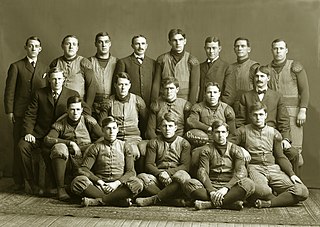
The 1904 Michigan Wolverines football team represented the University of Michigan in the 1904 Western Conference football season. In the team's fourth season under head coach Fielding H. Yost, the Wolverines compiled a perfect 10–0 record and outscored opponents 567–22. The 1904 team was the fourth of Yost's legendary "Point-a-Minute" teams. Michigan's games were of varying length from 22½ minutes to 70 minutes. Over the course of ten games, Michigan played 476 minutes of football and averaged a point scored for every 50.3 seconds played. The team included future College Football Hall of Fame inductee Willie Heston, who scored 20 touchdowns for 100 points that season; touchdowns were worth five points under 1904 rules.
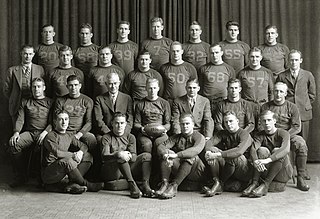
The 1930 Michigan Wolverines football team represented the University of Michigan in the 1930 college football season. The head coach was former Michigan star, 31-year-old Harry Kipke, in his second year in the position.
The 1942 Michigan Wolverines football team represented the University of Michigan in the 1942 Big Ten Conference football season. The 1942 team compiled a record of 7–3 and was ranked No. 9 in the final Associated Press poll. The team's line that included Albert Wistert, Merv Pregulman, Julius Franks, Elmer Madar, Robert Kolesar, Bill Pritula and Philip Sharpe and was known as the "Seven Oak Posts."
The 1941 Michigan Wolverines football team represented the University of Michigan in the 1941 Big Ten Conference football season. Under fourth-year head coach Fritz Crisler, Michigan compiled a record of 6–1–1, outscored opponents 147 to 41 and was ranked No. 5 in the final AP Poll. The team played three ranked opponents, defeating No. 5 Northwestern (14–7), playing to a tie with No. 14 Ohio State (20–20), and losing by a 7–0 score to the 1941 Minnesota team that won the 1941 national championship. With a strong, veteran line, the Wolverines also shut out four of their eight opponents: Pittsburgh (40–0); Columbia (28–0); Illinois (20–0); and Iowa (6–0).
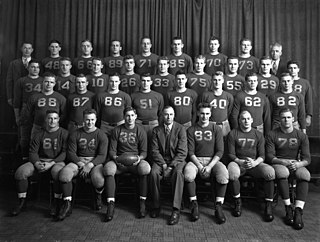
The 1943 Michigan Wolverines football team represented the University of Michigan in the 1943 Big Ten Conference football season. Fritz Crisler, in his sixth year as head coach, led the team to an 8–1 record and a tie with Purdue for the Western Conference championship. The team was ranked No. 3 in the final AP Poll behind Notre Dame and the Iowa Pre-Flight School. Michigan outscored its opponents 302 to 73 in nine games. The team's total of 302 points was the highest point total for a Michigan team since the 1917 team scored 304 points in 10 games. Defensively, the team held every opponent, except Notre Dame, to seven or fewer points.

The 1905 Michigan Wolverines football team represented the University of Michigan in the 1905 Western Conference football season. The team's head football coach was Fielding H. Yost. The Wolverines played their home games at Regents Field. After winning the first 12 games of the season by a combined score of 495–0, the team lost the final game of the season by a score of 2–0 against the University of Chicago.

The 1917 Michigan Wolverines football team represented the University of Michigan in the 1917 college football season. In his 17th year as head coach, Fielding H. Yost led the Michigan Wolverines football team to an 8–2 record, as Michigan outscored its opponents by a combined score of 304 to 53. Michigan won its first eight games and outscored those opponents by a combined score of 292 to 16. The team then lost its final two games against Penn and Northwestern.

The 1916 Michigan Wolverines football team represented the University of Michigan in the 1916 college football season. In his 16th year as head coach, Fielding H. Yost led Michigan to a 7–2 record, as the Wolverines outscored their opponents by a combined score of 253 to 56. Michigan held its first five opponents to a combined total of three points and won its first seven games by a combined score of 227 to 23. The team then lost its final two games, each game by a margin of only three points, against Cornell and Penn.
The 1945 Michigan Wolverines football team represented the University of Michigan in the 1945 Big Ten Conference football season. In their eighth year under head coach was Fritz Crisler, the Wolverines compiled a 7–3 record and finished the season ranked #6 in the final Associated Press Poll. Quarterback Joe Ponsetto was the team captain, and center Harold Watts won the Most Valuable Player award and was selected as a first-team All-Big Ten Conference player.
The 1944 Michigan Wolverines football team represented the University of Michigan in the 1944 Big Ten Conference football season. Under seventh-year head coach Fritz Crisler, Michigan compiled a record of 8–2, outscored opponents 204 to 91, finished in second place in the Big Ten Conference, and was ranked #8 in the final AP Poll. The team opened the season with a victory over an Iowa-Pre-Flight team that won all of its remaining games and ended the season ranked #6 in the final AP Poll. The Wolverines then shut out four opponents: Marquette (14-0); Northwestern (27-0); Illinois (14-0); and Wisconsin (14-0). The team's two losses came against Indiana and an undefeated Ohio State team that was ranked #2 in the final AP Poll.
The 1934 Michigan Wolverines football team was an American football team that represented the University of Michigan in the 1934 Big Ten Conference football season. In their sixth season under head coach Harry Kipke, the Wolverines compiled a 1–7 record and finished last in the Big Ten. Prior to the 1934 season, the Wolverines had compiled a 22-game undefeated streak dating back to October 1931.
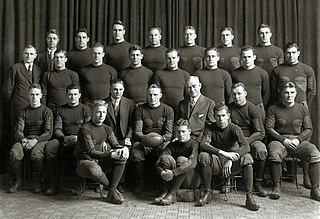
The 1929 Michigan Wolverines football team was an American football team that represented the University of Michigan in the 1929 Big Ten Conference football season. The team compiled a 5–3–1 record, tied for seventh place in the Big Ten, and outscored its opponents by a total of 109 to 75. In late May 1929, Tad Wieman was removed as the team's head coach. Harry Kipke was hired as his replacement in mid-June; Kipke remained as Michigan's head football coach for nine seasons.

The 1928 Michigan Wolverines football team was an American football team that represented the University of Michigan in the 1928 Big Ten Conference football season. The Wolverines compiled a 3–4–1 record, tied for seventh place in the Big Ten, and were outscored by their opponents by a total of 62 to 36.

The 1927 Michigan Wolverines football team represented the University of Michigan in the 1927 Big Ten Conference football season. The 1927 season was Michigan's first in its new stadium, Michigan Stadium. It was also the first under new head coach Tad Wieman following the retirement of Fielding H. Yost as head coach. Michigan shut out its first four opponents before losing to 1927 Big Ten Conference champion Illinois and later to Big Ten runner up Minnesota. Michigan compiled a record of 6–2 and outscored its opponents by a combined score of 137 to 39. The team was ranked No. 7 in the nation in the Dickinson System ratings released in December 1927.

The 1921 Michigan Wolverines football team represented the University of Michigan in the 1921 Big Ten Conference football season. In his 21st year as head coach, Fielding H. Yost led Michigan to a 5–1–1 record, as the Wolverines outscored their opponents with a combined score of 187 to 21. Michigan recorded shutouts in five of its seven games, allowing only 14 points in a loss to Ohio State and 7 points in a tie with Wisconsin. Over the course of five home games at the newly expanded Ferry Field, the Wolverines attracted crowds totaling 143,500 with receipts totaling $170,000.
The 1900 Stanford Cardinal football team represented Stanford University in the 1900 college football season. In their first and only season under head coach Fielding H. Yost, the team compiled a 7–2 record, shut out seven of nine opponents, scored 154 points, and allowed 20 points by opponents. The team registered three shutouts against the Reliance Club, two shutouts against California State Normal School, now known as San Jose State University, and single game shutouts against Oregon and California. The team's two losses came against Nevada (0–6) and a Stanford alumni team (0–14) that featured coach Yost playing at the fullback position.

